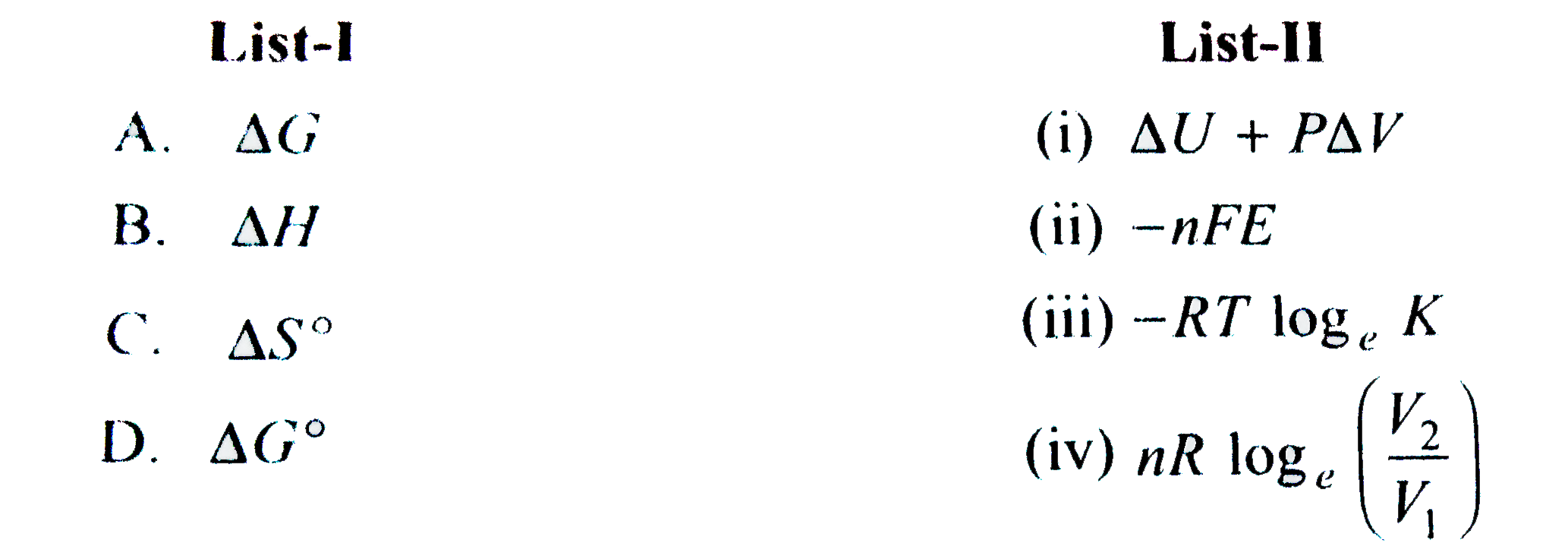One mole of N2 (g) is taken in 1 litre empty container fitted with a movable piston at 300 K at constant pressure then match the change (List-II) in parameters (List-I) of gas as compared to initial state and select the correct code.
List-I(Parameter)List-II(Change)(a)Z1(number of collisions made by a molecule per unit time)(1)18(q)Z11(collision frequency)(2)2(r)λ(mean free path)(3)12(s)Urms(root mean square speed)(4)4
P Q R S2 4 1 3
P Q R S1 2 4 3
P Q R S3 4 1 2
P Q R S2 1 4 2
The correct Answer is:(p-3);(q-1);(r-4);(s-2)
Step by step video, text & image solution for One mole of N_(2) (g) is taken in 1 litre empty container fitted with a movable piston at 300 K at constant pressure then match the change (List-II) in parameters (List-I) of gas as compared to initial state and select the correct code. {:(,"List-I(Parameter)",,"List-II(Change)"),("(a)",Z_(1)("number of collisions made by a molecule per unit time"),,(1)1/8),("(q)",Z_(11)("collision frequency"),,"(2)2"),("(r)",lambda("mean free path"),,(3)1/2),("(s)",U_(rms)("root mean square speed"),,"(4)4"):} by Chemistry experts to help you in doubts & scoring excellent marks in Class 11 exams.
Topper's Solved these Questions
Similar Questions
For the reaction CO(g)+H2O(g)⇔CO2(g)+H2(g) at a given temperature the equilibrium amount of CO2(g) can be increased by :
05:18View SolutionTotal nubler of mono chlorodervatives obrained by replacement of H by Cl in propene are :
View SolutionMatch List I with List II and select the correct answer using the codes given below the lists: {:(,"List I",,,"List II"),(P.,"Boltzmann constant",,1.,[ML^(2)T^(-1)]),(Q.,"Coefficient of viscosity",,2.,[ML^(-1)T^(-1)]),(R.,"Planck constant",,3.,[MLT^(-3)K^(-1)]),(S.,"Thermal conductivity",,4.,[ML^(2)T^(-2)K^(-1)]):}
01:17View SolutionMatch the list I with list II and select the correct answer using the code given below the lists. {:(,"List I",,"List II",),(P,Sr^(2+),1,"Golden yellow",),(Q,K^(+),2,"Apple green",),(R,Na^(+),3,"Crimson red",),(S,Ba^(2+),4,"Lilac",):}
02:42View SolutionMatch List I with List II and select the correct answer using the code given below the Lists:
List IList II(Physical quantity)(Unit)A. Distance1. MoleB. Amount of material2. CoulombC. Amount of electrical change3. Light yearD. energy4. Watt hourView Solutionmatch List I which List II ans select the correct answer using to code given below the lists
List IList IIA.A cube root of unity1.−2(1+i)B.A square root of -12.2iC.Cube of 1-i3.2iD.Square of 1+i4.−12(1+i√3)View SolutionMatch the List I with List II and select the correct answer using. The code given below the lists.
List I List IIAPressure1inertBXe2Charles lawCPV=Constant3Pascal4hot air balloon4Boyle's law10:54View SolutionMatch the List I with List II and select the answer using the code given below the list . {:(," List I",," List II"),(A,"Pressure",2,"Intensive property"),(B,"Number of moles",3,"Path function"),(C,"Density",3,"Extensive property"),(D,"Work",4,"State function"):}
03:01View SolutionMatch the chemical conversions in List with the appropriate reagent in List II and select the correct answer using the code given below the lists: List I List II 1. (i) Hg(OAc)_2, (ii) NaBH_2 2. (i) alcKOH 3. Et-Br 4. (i) BH_3, (ii) H_2O_2//NaOH
03:01View SolutionMatch the list - I with List - II
List (Electrode)List - II(Type)1.CalomelP.Reference2.GlassQ.Redox3HydrogenR.Membrane4.QuinhydroneS.Gas02:55View SolutionMatch list I with list II and select this correct answer using the codes given below the lists. {:(,"List - I",,"List - II"),((p),"Nucleic acids",1.,DNA),((q),"Uracil",2.,"Hormones"),((r),"Thymine",3.,"Polynucleotides"),((s),"Double - helix structure",4.,"RNA"):}
View Solution ltBrgt Match the physical changes in List-I with their relations given in List-II:View Solution
ltBrgt Match the physical changes in List-I with their relations given in List-II:View SolutionMatch the list I and II using the code given below the list . {:(,"List -I",,"List - II"),(A.,t_(1//2)" of first order reaction",1.,k=2.303/tlog.[((A_0))/((A))]),(B.,t_(1//2)"of "n^(th)"order",2.,f=e^(-(E_a)/(RT))),(C.,"Fraction of effective collision",3.,(0.6932)/k),(D.,"Rate constant of first order reaciton",4.,(2^(n-1)-1)/((n-1)k(A_0)^(n-1))):} code
01:12View SolutionMatch List I with List II and select the correct answer:
List I(ion)1List II (Shapes)AICl−21LinearBBrF+22PyramidalCCIF−43TetrahedralDAICl−44Square planar5Angular01:35View SolutionMatch the list - I with List - II {:(,"List (Electrode)",,"List - II(Type)"),(1.,"Calomel",P.,"Reference"),(2.,"Glass",Q.,"Redox"),(3,"Hydrogen",R.,"Membrane"),(4.,"Quinhydrone",S.,"Gas"):}
05:37View Solution

